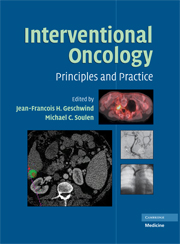Book contents
- Frontmatter
- Contents
- FOREWORD
- ACKNOWLEDGMENTS
- CONTRIBUTORS
- PART I PRINCIPLES OF ONCOLOGY
- PART II PRINCIPLES OF IMAGE-GUIDED THERAPIES
- PART III ORGAN-SPECIFIC CANCERS
- PART IV SPECIALIZED INTERVENTIONAL TECHNIQUES IN CANCER CARE
- 42 Vascular Access: Venous and Arterial Ports
- 43 Gastrointestinal Stenting
- 44 Diagnosis and Management of Superior Vena Cava Syndrome
- 45 Palliative Care and Symptom Management
- 46 Complications of Therapeutic Endovascular Procedures in Malignant Liver Diseases
- INDEX
- Plate section
- References
46 - Complications of Therapeutic Endovascular Procedures in Malignant Liver Diseases
from PART IV - SPECIALIZED INTERVENTIONAL TECHNIQUES IN CANCER CARE
Published online by Cambridge University Press: 18 May 2010
- Frontmatter
- Contents
- FOREWORD
- ACKNOWLEDGMENTS
- CONTRIBUTORS
- PART I PRINCIPLES OF ONCOLOGY
- PART II PRINCIPLES OF IMAGE-GUIDED THERAPIES
- PART III ORGAN-SPECIFIC CANCERS
- PART IV SPECIALIZED INTERVENTIONAL TECHNIQUES IN CANCER CARE
- 42 Vascular Access: Venous and Arterial Ports
- 43 Gastrointestinal Stenting
- 44 Diagnosis and Management of Superior Vena Cava Syndrome
- 45 Palliative Care and Symptom Management
- 46 Complications of Therapeutic Endovascular Procedures in Malignant Liver Diseases
- INDEX
- Plate section
- References
Summary
In recent years, intra-arterial treatment has become one of the first options in the therapeutic approach to primary and metastatic liver tumors. In spite of having good results, these endovascular procedures are not exempt of complications that have to be understood and promptly recognized in order to decrease their morbidity and mortality. The most common complications are described subsequently and distributed in three main groups. First, the complications arising from embolization of liver tumors, with reference to systemic toxicities (post-embolization syndrome [PES], hepatic insufficiency and changes in portal pressure), local complications (rupture of hepatocarcinoma [HCC] and biliary complications) and distant complications (pulmonary embolism of lipiodol or particles and metastatic spread of disease in the lungs). Secondly, the complications related to chemotherapy administered directly from the hepatic artery are then discussed, with mention of the complications caused by the catheter (migration and arterial obstruction), and complications associated with drug infusion in the extra-hepatic arteries. Finally, the complications of radioembolization, a relatively new approach that is performed with microspheres loaded with 90Ytrium (90Y) are also discussed.
EMBOLIZATION OF HEPATIC TUMORS
Systemic Toxicities
Post-embolization Syndrome
PES is characterized by a set of signs and symptoms occurring after embolization. Some of them are subjective and hard to quantify, which include nausea, vomiting, abdominal pain, fever and hypertransaminasemia, lasting a maximum of 7 to 10 days (1, 2) with variable incidence according to the diagnostic criteria (15% to 90%).
- Type
- Chapter
- Information
- Interventional OncologyPrinciples and Practice, pp. 589 - 598Publisher: Cambridge University PressPrint publication year: 2008



